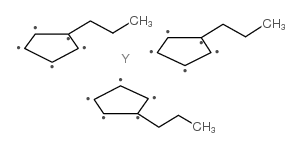329735-73-1
| 中文名 | 三(丙基环戊二烯)化钇 |
|---|---|
| 英文名 | 2-propan-2-ylcyclopenta-1,3-diene,yttrium(3+) |
| 中文别名 |
三(丙基环戊二烯)化钇
三(正丙基环戊二烯)钇(III) |
| 英文别名 | MFCD00145488 |
| 分子式 | C24H33Y |
|---|---|
| 分子量 | 410.42500 |
| 精确质量 | 410.16400 |
| LogP | 6.57540 |
| 计算化学 | 1.疏水参数计算参考值(XlogP):无 2.氢键供体数量:0 3.氢键受体数量:3 4.可旋转化学键数量:3 5.互变异构体数量:无 6.拓扑分子极性表面积0 7.重原子数量:25 8.表面电荷:0 9.复杂度:127 10.同位素原子数量:0 11.确定原子立构中心数量:0 12.不确定原子立构中心数量:0 13.确定化学键立构中心数量:0 14.不确定化学键立构中心数量:0 15.共价键单元数量:4 |
|
Section 1: Product Identification Chemical Name:Tris(n-propylcyclopentadienyl)yttrium (99.9%-Y) (REO) CAS Registry Number:329735-73-1 Formula:(C3H7C5H4)3Y EINECS Number:none Chemical Family:metallocene Synonym:none
Section 2: Composition and Information on Ingredients IngredientCAS NumberPercentACGIH (TWA)OSHA (PEL) Title Compound329735-73-1100%1mg/m3 as Y1mg/m3 as Y Section 3: Hazards Identification Dust may be irritating to skin, eyes and mucous membranes of nose and throat. Moisture may liberate heat Emergency Overview: and vapors of n-propylcyclopentadiene. Primary Routes of Exposure:Ingestion, eyes, inhalation, skin Eye Contact:May cause slight to mild irritation of the eyes. Skin Contact:May cause slight to mild irritation of the skin. Moisture can cause hydrolysis and possible thermal burns. Inhalation:Dust may be irritating to the nose, mucous membranes and respiratory tract. No specific information on the physiological effects of ingestion. Ingestion may lead to thermal burns, vomiting Ingestion: and diarrhea. Acute Health Affects:May be irritating to skin, eyes and respiratory tract. Chronic Health Affects:No information available on long-term chronic effects. NTP:No IARC:No OSHA:No SECTION 4: First Aid Measures Immediately flush the eyes with copious amounts of water for at least 10-15 minutes. A victim may need Eye Exposure: assistance in keeping their eye lids open. Get immediate medical attention. Wash the affected area with water. Remove contaminated clothes if necessary. Seek medical assistance if Skin Exposure: irritation persists. Remove the victim to fresh air. Closely monitor the victim for signs of respiratory problems, such as difficulty in Inhalation: breathing, coughing, wheezing or pain. In such cases seek immediate medical assistance. Seek medical attention immediately. Keep the victim calm. Give the victim water (only if conscious). Induce Ingestion: vomiting only if directed by medical personnel. SECTION 5: Fire Fighting Measures Flash Point:not applicable Autoignition Temperature:none Explosion Limits:none Extinguishing Medium:carbon dioxide, dry powder If this product is involved in a fire, firefighters should be equipped with NIOSH approved positive pressure Special Fire Fighting Procedures: self-contained breathing apparatus and full protective clothing. Hazardous Combustion andIf involved in a fire this material may emit toxic organic fumes. Decomposion Products: Unusual Fire or Explosion Hazards: Flammable solid. Evolves flammable n-propylcyclopentadiene with water. SECTION 6: Accidental Release Measures Spill and Leak Procedures:Small spills may be adsorbed into diatomaceous earth, sand, or other suitable adsorbent, and swept up. SECTION 7: Handling and Storage Handle and store the material under an inert atmosphere of nitrogen or argon. Keep away from heat and Handling and Storage: sources of ignition. Do not raise dust. SECTION 8: Exposure Controls and Personal Protection Eye Protection:Always wear approved safety glasses when handling a chemical substance in the laboratory. Skin Protection:Wear appropriate chemical resistant gloves and protective clothing. Ventilation:The material will react with air and moisture. Handle under an inert atmosphere of nitrogen or argon. If in form of fine dust and ventilation is not available a respirator should be worn. The use of respirators Respirator: requires a Respiratory Protection Program to be in compliance with 29 CFR 1910.134. Ventilation:The material will react with air and moisture. Handle under an inert atmosphere of nitrogen or argon. Additional Protection:No additional protection required. SECTION 9: Physical and Chemical Properties Color and Form:yellow solid Molecular Weight:410.44 Melting Point:no data Boiling Point:no data Vapor Pressure:no data Specific Gravity:no data Odor:none Solubility in Water:insoluble SECTION 10: Stability and Reactivity Stability:air and moisture sensitive Hazardous Polymerization:no hazardous polymerization Conditions to Avoid:Contact with air or water. Mixtures of fine dust with air. Incompatibility:Water, alcohols, oxidizers, oxygen, halogens, halocarbons, mineral acids. Decomposition Products:carbon monoxide, carbon dioxide, yttrium oxide and organic fumes. SECTION 11: Toxicological Information RTECS Data:No information available in the RTECS files. Carcinogenic Effects:No data available Mutagenic Effects:No data available Tetratogenic Effects:No data available SECTION 12: Ecological Information Ecological Information:No information available. SECTION 13: Disposal Considerations Disposal:Dispose of according to local, state and federal regulations. SECTION 14: Transportation Shipping Name (CFR):Flammable solids, Organic, N.O.S. Hazard Class (CFR):4.1 Additional Hazard Class (CFR):NA Packaging Group (CFR):II UN ID Number (CFR):UN# 1325 Shipping Name (IATA):Flammable solid, Organic, N.O.S. Hazard Class (IATA):4.1 Additional Hazard Class (IATA):NA Packaging Group (IATA):II UN ID Number (IATA):UN# 1325 SECTION 15: Regulatory Information TSCA:Not listed in the TSCA inventory SARA (Title 313):Title compound not listed Second Ingredient:none SECTION 16 - ADDITIONAL INFORMATION N/A |
| 危险品运输编码 | UN3181 |
|---|---|
| 包装等级 | III |
| 危险类别 | 4.1 |


